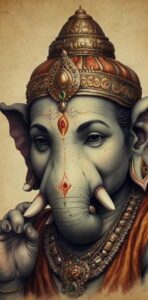
oṃ bāṇarāvaṇacaṇḍīśapūjitāya namo namaḥ oṃ
ॐ बाणरावणचण्डीशपूजिताय नमो नमः ॐ
This verse highlights the universal reverence for Ucchista Ganapati, recognizing His divine status and the devotion He commands across diverse beings, including powerful kings and deities.
1. “Bāṇa” (बाण):
- Bāṇa refers to Bāṇāsura, a powerful asura (demon) king in Hindu mythology, known for his immense strength, devotion, and complex character.
- Despite being an asura, Bāṇa is often depicted as a devotee of Śiva. His reverence for Ganapati signifies the transcendental nature of Ganapati’s divinity—beyond good and evil, capable of inspiring awe and worship in all beings.
- This reference suggests that Ucchista Ganapati is not limited by traditional boundaries and is worshipped by even those who challenge divine order.
2. “Rāvaṇa” (रावण):
- Rāvaṇa, the king of Lanka and a devotee of Śiva, is another complex figure from the Rāmāyaṇa. Known for his intellectual prowess, musical abilities, and strength, Rāvaṇa’s worship of Ganapati further underscores Ganapati’s universal appeal.
- Rāvaṇa’s devotion reflects the acknowledgment of Ganapati’s supremacy, even by those who possess extraordinary power and intellect.
3. “Caṇḍīśa” (चण्डीश):
- Caṇḍīśa is an epithet of Lord Śiva, particularly in His fierce and protective form. The inclusion of Śiva emphasizes the connection between Ganapati and His father, reinforcing Ganapati’s divine lineage and importance within the Hindu pantheon.
- Śiva’s worship of Ganapati signifies that even the most revered deities honor Ganapati’s role as the remover of obstacles and the initiator of auspiciousness.
4. Universal Reverence:
- This verse illustrates how Ucchista Ganapati transcends human, divine, and even demonic realms, earning devotion from beings of all kinds—kings, demons, and gods alike.
- By referencing Bāṇa, Rāvaṇa, and Caṇḍīśa, the verse symbolizes the inclusivity of Ganapati’s worship, affirming His role as a deity beyond sectarian divides.
5. Symbolism of Worship by Kings and Deities:
- The asura kings (Bāṇa and Rāvaṇa) symbolize worldly power, ambition, and material pursuits. Their worship of Ganapati represents the surrender of ego and the recognition of a higher divine order.
- Śiva’s worship reflects the harmony between Ganapati and cosmic forces, highlighting Ganapati’s integral role in the spiritual and universal balance.
6. Devotional Aspect:
- The repeated namo namah underscores complete surrender and reverence. By bowing to the One worshipped by the mightiest beings, devotees acknowledge that all power ultimately belongs to Ucchista Ganapati.
Conclusion:
Verse 32 of the Ucchista Ganapati Ashtastotram celebrates Ucchista Ganapati’s universal significance and His worship by figures representing diverse aspects of existence—earthly kings, spiritual deities, and even forces of opposition. This highlights Ganapati’s transcendence over dualities, His ability to inspire devotion in all realms, and His role as the ultimate source of guidance and strength. Through this verse, devotees are reminded of Ganapati’s unparalleled greatness and are encouraged to seek His blessings with humility and devotion.
Discover more from Dr Pallavi Kwatra
Subscribe to get the latest posts sent to your email.

